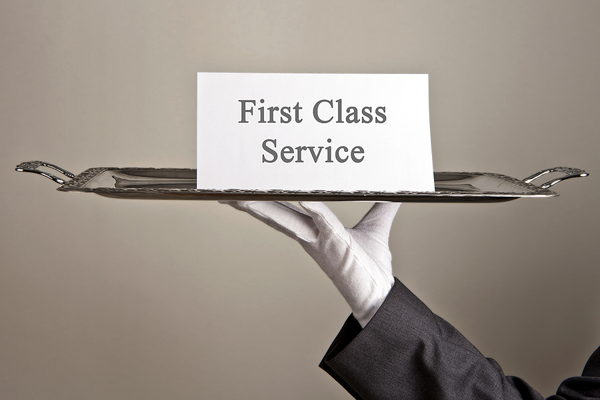Okay, you are a school administrator and schools are serious business, right? Professional and no-nonsense? Well, I agree with the professional part, but I think some schools (whether it is established by the school culture, the HR department hiring policies, or maybe the school leader) may want to consider factoring a little joy into the mix. It isn’t an either/or proposition because professionalism and happiness are not mutually exclusive.
Whose face greets the public in your front offices? Do they recognize the importance of their role (regardless of their job description or skill sets)? From a public relations perspective, your front desk personnel may be as important as nearly every other position in your school. As the first person a parent, student, community member, or new staff member meets when they arrive at your school, your receptionist or assistant sets the tone.
Is it a happy, welcoming, sincere, and helpful impression? Your front desk staff sets the tone for whatever happens next—whether greeting a new student who is a bit apprehensive about his or her new school, a parent coming in to address a concern, or a staff member who needs to meet with you, your office staff’s attitude can create a positive environment that will influence the whole experience.
How do you feel when you enter an office and the receptionist stands to greet you with a smile, obviously happy to assist you? What a difference from the “I’m way too busy to be bothered with you, no eye-contact, grumbled and impatient ‘Yes?'” that may greet you instead?
Hire happy people
Hopefully you are already encouraging your staff to smile and be welcoming, and that is definitely a good idea, but studies show that most of us know the difference between a sincere smile and a social smile. So, it might be easier to just hire happy people in the first place.
Author Dan Hill is an expert in facial coding. In his book About Face, he cites studies that show that our “expected social behavior” smile is different from the one that is actually joyful. While the book is about advertising, there is a lot to be learned about the tie between our primal responses and the overall feeling we come away with (in marketing or customer service).
Our brain is capable of telling the difference, and feeling joy is a pretty hard thing to fake. Our brain knows the difference. When we smile socially, we use fewer muscles (primarily facial muscles) than when we engage a real smile. In another test, restaurant patrons who felt that servers displayed true smiles were far more satisfied with the service they received. Evidently, our brains recognize sincerity.

Few of us would argue with any of this since most of us know it intuitively. I can still remember the stern line of my mother’s mouth when I was in trouble, but I learned quickly that there was often a smile that reached her eyes and betrayed her—a dead give-away that I wasn’t really in that much trouble after all!
We, as humans, are primarily emotional decision-makers, which means our emotions will have an impact on what impressions we form about any given experience. First meetings of your publics—with your front office, your staff, and you—will be influenced by their emotional interpretations.
So, the moral of the story? Be aware that if during the hiring process your candidate doesn’t demonstrate positive, sincere emotions, it isn’t likely they will do so during a customer service situation either. It is certainly something to consider when it comes to staffing those publicly visible roles. Consider including an evaluation of the emotions candidates project during an interview in an effort to hire happy people. And, take it from a savvy kid, look for those smiling eyes!

Implementing improvements
One of my admin team and I took a business “road trip” a few years ago. We visited several states and many school offices—from the very large district to the tiniest rural school. It was a very enlightening process. There were schools we immediately “liked,” and when we left we took with us a positive, professional impression. A few appalled us by their unprofessional treatment or downright rudeness. [Hint: a higher percentage of private schools got an A+ rating than public schools—which means public schools, worried about losing students to charters, private schools, or homeschooling, may need to look only as far as their front office to stop the bleeding.]
Coming from a public relations background, I wish the administrators of those schools would realize what small steps it would take to correct the poor first impressions of the negative school and hope they rewarded the positive, respectful, and pleasant behavior of their staff in the positive offices. Not sure where your school might fall?
- Set expectations for your staff. If they know you value a welcoming, smiling, helpful response to each visitor in your office, most staff will try to rise to those expectations.
- Test your school’s typical front office experience by having someone unknown to your staff stop by the office to observe the experience through objective eyes. What you see as an administrator isn’t necessarily what total strangers experience. (Okay, it sounds a bit like spying, but I’d rather call it objective analysis.)
- Reward desired behavior. This doesn’t have to be with pay raises or promotions but can be as simple as a positive evaluation that specifically identifies the behaviors you are striving to instill. It could be recognition through an internal process like an award on the intranet so they are recognized by their peers or even a positive news article on the public-facing website. (Remember to add a photo of this person’s smiling face in the article.)

For some more tips about improving that first impression and improving customer support within your schools, maybe these articles will help get your school on track:
From Good to Great: Customer Service
Roll Out the Welcome Mat at Your School
Is Your Front Office Helping or Hurting Your School Enrollment
What is poor customer service costing your school?
20 tips to amazing customer service at your school
Communication! It’s all about customer service









